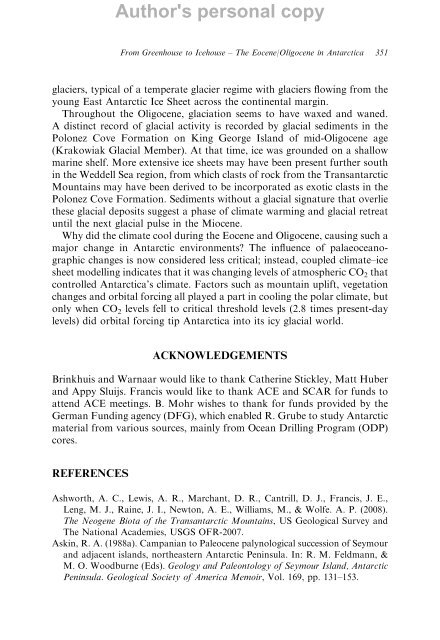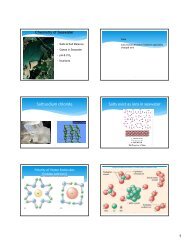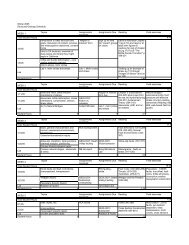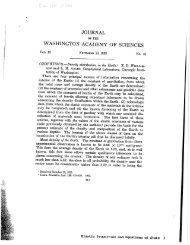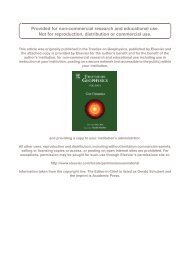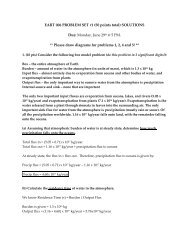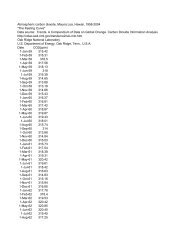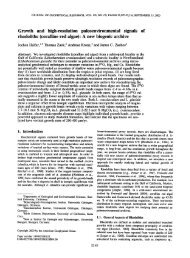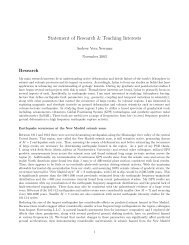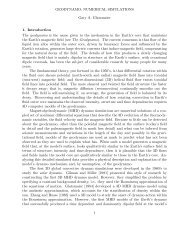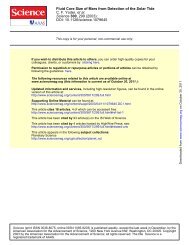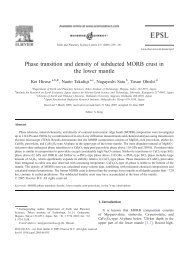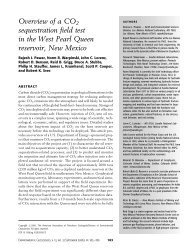From Greenhouse to Icehouse – The Eocene/Oligocene - UMass ...
From Greenhouse to Icehouse – The Eocene/Oligocene - UMass ...
From Greenhouse to Icehouse – The Eocene/Oligocene - UMass ...
You also want an ePaper? Increase the reach of your titles
YUMPU automatically turns print PDFs into web optimized ePapers that Google loves.
glaciers, typical of a temperate glacier regime with glaciers flowing from the<br />
young East Antarctic Ice Sheet across the continental margin.<br />
Throughout the <strong>Oligocene</strong>, glaciation seems <strong>to</strong> have waxed and waned.<br />
A distinct record of glacial activity is recorded by glacial sediments in the<br />
Polonez Cove Formation on King George Island of mid-<strong>Oligocene</strong> age<br />
(Krakowiak Glacial Member). At that time, ice was grounded on a shallow<br />
marine shelf. More extensive ice sheets may have been present further south<br />
in the Weddell Sea region, from which clasts of rock from the Transantarctic<br />
Mountains may have been derived <strong>to</strong> be incorporated as exotic clasts in the<br />
Polonez Cove Formation. Sediments without a glacial signature that overlie<br />
these glacial deposits suggest a phase of climate warming and glacial retreat<br />
until the next glacial pulse in the Miocene.<br />
Why did the climate cool during the <strong>Eocene</strong> and <strong>Oligocene</strong>, causing such a<br />
major change in Antarctic environments? <strong>The</strong> influence of palaeoceanographic<br />
changes is now considered less critical; instead, coupled climate<strong>–</strong>ice<br />
sheet modelling indicates that it was changing levels of atmospheric CO 2 that<br />
controlled Antarctica’s climate. Fac<strong>to</strong>rs such as mountain uplift, vegetation<br />
changes and orbital forcing all played a part in cooling the polar climate, but<br />
only when CO 2 levels fell <strong>to</strong> critical threshold levels (2.8 times present-day<br />
levels) did orbital forcing tip Antarctica in<strong>to</strong> its icy glacial world.<br />
ACKNOWLEDGEMENTS<br />
Brinkhuis and Warnaar would like <strong>to</strong> thank Catherine Stickley, Matt Huber<br />
and Appy Sluijs. Francis would like <strong>to</strong> thank ACE and SCAR for funds <strong>to</strong><br />
attend ACE meetings. B. Mohr wishes <strong>to</strong> thank for funds provided by the<br />
German Funding agency (DFG), which enabled R. Grube <strong>to</strong> study Antarctic<br />
material from various sources, mainly from Ocean Drilling Program (ODP)<br />
cores.<br />
REFERENCES<br />
Author's personal copy<br />
<strong>From</strong> <strong>Greenhouse</strong> <strong>to</strong> <strong>Icehouse</strong> <strong>–</strong> <strong>The</strong> <strong>Eocene</strong>/<strong>Oligocene</strong> in Antarctica 351<br />
Ashworth, A. C., Lewis, A. R., Marchant, D. R., Cantrill, D. J., Francis, J. E.,<br />
Leng, M. J., Raine, J. I., New<strong>to</strong>n, A. E., Williams, M., & Wolfe. A. P. (2008).<br />
<strong>The</strong> Neogene Biota of the Transantarctic Mountains, US Geological Survey and<br />
<strong>The</strong> National Academies, USGS OFR-2007.<br />
Askin, R. A. (1988a). Campanian <strong>to</strong> Paleocene palynological succession of Seymour<br />
and adjacent islands, northeastern Antarctic Peninsula. In: R. M. Feldmann, &<br />
M. O. Woodburne (Eds). Geology and Paleon<strong>to</strong>logy of Seymour Island, Antarctic<br />
Peninsula. Geological Society of America Memoir, Vol. 169, pp. 131<strong>–</strong>153.


